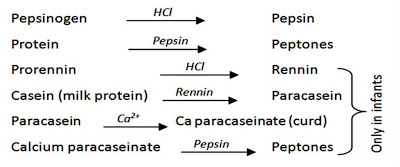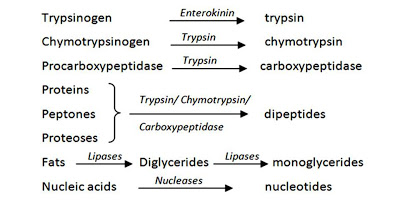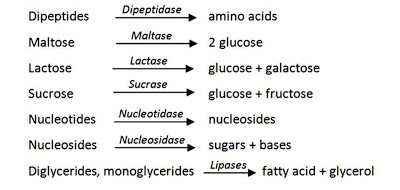Biology
Food provides energy for life activities, materials for growth, maintains body temperature and repair tissues.
Food consists of carbohydrates, proteins, fats (lipids), vitamins, minerals and water.





- Cholera
Term: cholera Origin: An Greek ????/chole (=gall, bile) as obstruction of the small intestine, even as far as the the jejunum and ileum of the small intestine, will usually cause the expulsion of intestinal contents which have already...
- Organs Derived From Germ Layers Of Embryo
Ectoderm Mesoderm Endoderm Skin (epidermis) and their pigment cells, hairs, nails. Connective tissues, superficial and deep fascia, ligaments, tendons, dermis of skin (from dermatotome) Epithelial part of mouth, some part of palate, tongue,...
- Structural Organization In Animals
Click here for PDF ANIMAL TISSUESA group of cells having same origin, structure and function are called the tissues. Animal tissues are 4 types:(i) Epithelial ...
- Important Glands And Corpuscles
Glands/Corpuscles Location Functions 1. Accessory glands Male reproductive system Activation and lubrication of sperms 2. Accessory glands Earthworm Copulation 3. Antennary...
- Ducts & Canals
Ducts/ canal Of which part 1. Anal canal In mammalian rectum 2. Aqueduct of Sylvius (iter) Between II & IV brain ventricles 3. ...
Biology
Digestion and Absorption
Click here for PDF
Nutrition is the getting and utilization of energy rich nutrients (food) by an organism.Food provides energy for life activities, materials for growth, maintains body temperature and repair tissues.
Food consists of carbohydrates, proteins, fats (lipids), vitamins, minerals and water.
HUMAN DIGESTIVE SYSTEM
Includes Alimentary canal & associated (Digestive) glands.
I. Alimentary canal (gut)
Includes the following parts
Mouth ? buccal cavity ? Pharynx ? Oesophagus ? Stomach (fundus ? cardiac stomach ? pyloric stomach) ? Small intestine (duodenum ? jejunum ? ileum) ? Large intestine (caecum ? colon ? rectum) ? anus.
· Mouth: To receive the food.
· Buccal cavity (oral or mouth cavity):
- Consists of palate, teeth & muscular tongue. Palate (roof) has anterior hard palate and posterior soft palate.
- Tongue helps in mastication, ingestion & deglutition (swallowing). Tongue contains taste buds.
- At the back, on either side of tongue tonsils present.
· Pharynx:
- Common passage for digestive and respiratory systems.
- When food materials pass through the pharynx, the epiglottis closes the glottis (opening of larynx) and prevents the entry of food into trachea.
· Oesophagus:
- Muscular tube with 30 cm long.
- Conducts food into stomach.
- At the posterior region of oesophagus, oesophageal sphincter (a circular muscle) is present. It controls the opening of oesophagus into stomach.
· Stomach:
- For storage and digestion of food.
- 3 parts: upper (anterior) fundus, middle cardiac stomach & lower (posterior) pyloric stomach (antrum).
- Pyloric stomach leads to small intestine by an opening called Pylorus, guarded by pyloric sphincter muscle.
- Inner wall of stomach bears rugae (longitudinal folds).
· Small intestine:
- Longest part of gut (7 m long and 2.5 cm diameter).
- Consists 3 parts, namely duodenum (C shaped first part), Jejunum (middle part) and Ileum (terminal part).
- Finger-like villi are seen at the mucosa. Each villus has a brush-bordered columnar epithelial layer provided with microvilli. Villus consists of a capillary network and a small lymph vessel (lacteal).
· Large intestine:
- 1.5 m long. Consists of caecum, colon and rectum.
- Caecum is well-developed in herbivores but in man it is very small. Arising from the caecum is a finger-like vestigial organ, the vermiform appendix.
- The colon consists of ascending colon, transverse colon, descending colon and pelvic colon.
- Pelvic colon leads to rectum that opens out by anus. Anus is guarded by sphincterni (circular voluntary muscles).
- In some herbivores, the large intestine consists of several cellulose digesting bacteria.
Teeth
The nature and mode of arrangement of teeth is called dentition. Human dentition is
· Heterodont (different kinds of teeth). They are incisors (I) for cutting, canines (C) for tearing, premolars (PM) and molars (M) for mastication. Premolars & molars are collectively called as cheek teeth which have cusps.
· Thecodont (teeth are placed in the sockets of jaw bones).
· Diphyodont (teeth appear twice in the lifetime. They are milk [decidual] teeth and permanent teeth). Milk teeth are erupted at 6-7 months of birth and 20 in number. They are replaced by permanent teeth at the age of 6-7. Permanent teeth are 32 in number. The last 4 molars (wisdom teeth) appear only at the age of 18.
Dental formula: It explains the kinds and number of teeth.
Human dental formula (of permanent teeth):
I 2/2 C 1/1 PM 2/2 M 3/3 x 2 = 32
Dental formula of milk dentition:
I 2/2 C 1/1 PM 0/0 M 2/2 x 2 = 20
Histology of human gut
Human gut is formed of 4 layers,
1. Mucosa: Innermost, moist epithelial layer. Contains secretory and absorptive cells.
2. Submucosa: Soft connective tissue layer just outside the mucosa. Nerves and blood vessels are present.
3. Muscularis externa: Outer to submucosa. Smooth muscle layer (inner circular & outer longitudinal muscles).
4. Serosa: Outermost fibrous layer.
II. Digestive glands
They secrete digestive juices. Include salivary glands, gastric glands, intestinal glands, pancreas and liver.
a. Salivary glands
- 3 pairs. They are 2 parotid (largest salivary gland), 2 sublingual & 2 submaxillary (submandibular) glands.
- Infection of parotid glands causes Mumps.
- Salivary glands secrete saliva. It contains 99.5% water, mucin, enzymes like salivary amylase (Ptyalin) and Lysozyme and electrolytes such as Na+, K+, Cl-, HCO3- etc.
b. Gastric glands
Tubular glands found on the inner wall. They consists of
a. Mucous neck cells: secrete mucous. Mucous and bicarbonates protect the stomach wall (mucosal epithelium) from HCl and prevents autodigestion.
b. Chief (zymogen or peptic) cells: secrete inactive enzymes like pepsinogen, prorennin and lipase.
c. Oxyntic (parietal) cells: secrete HCl & Castle?s gastric factor. Gastric glands secrete acidic (pH 1.8-2.0) gastric juice (99.5% water and 0.5% residual substances).
c. Liver
- Largest gland (1.5 kg). Reddish brown.
- Bilobed (large right lobe & small left lobe). Each lobe is formed of many hepatic lobules (functional units).
- A lobule has many hepatic cells arranged as radiating plates around a central vein. They secrete alkaline bile juice. Liver lobule is covered by Glisson?s capsule. Between the plates are blood filled hepatic sinusoids.
- The Kupffer?s cells present in the sinusoids engulf and remove bacteria, damaged cells etc from blood.
- Bile ? Hepatic duct ? Gall bladder ? Cystic duct ? Bile duct ? Common hepato-pancreatic duct ? Duodenum.
- Hepato-pancreatic duct is guarded by sphincter of Oddi.
- Bile has no enzymes but contains bile pigments (bilirubin and biliverdin), bile salts, cholesterol and phospholipids.
d. Pancreas
- Second largest gland. Seen near duodenal loop.
- It is a cream-coloured heterocrine gland, i.e. it has both exocrine and endocrine (islets of Langerhans) parts.
- The exocrine part has a pancreatic duct that opens into duodenum along with bile duct (hepato-pancreatic duct).
- Pancreas (exocrine) secretes alkaline pancreatic juice. It contains inactive enzymes (trypsinogen, chymotrypsinogen & procarboxypeptidases), amylases, lipases & nucleases.
e. Intestinal glands
- Simple tubular glands. 2 types
1. Crypts of Lieberkuhn: consists of muc ous-secreting Goblet cells and enzyme-secreting Paneth cells.
2. Brunner (duodenal) glands: confined to submucosa of duodenum. Secrete mucous only.
- Intestinal glands secrete alkaline intestinal juice (succus entericus) which contains enzymes such as maltase, lactase, sucrase, dipeptidase, lipases, nucleotidases, nucleosidases etc. The bicarbonate and mucous provide alkaline medium and protect intestinal mucosa.
DIGESTION OF FOOD
Digestion is the conversion of complex insoluble food materials into simple and absorbable form. It includes mechanical processes such as mastication (chewing), deglutition (swallowing) & peristalsis (wave-like movement of food bolus through the gut by muscular contraction).
· Digestion in buccal cavity: Only starch digestion.
Ptyalin converts starch (polysaccharide) into disaccharides. About 30% of starch is digested by ptyalin.
· Digestion in stomach: Stomach stores food for 4-5 hrs. It is mixed with gastric juice by the churning movements and is converted into acidic pasty form (chyme).
The gastric lipase hydrolyses a small amount of lipids.
· Digestion in small intestine: Chyme is mixed with succus entericus, pancreatic juice & bile juice. Pancreatic juice & bile reach the duodenum through hepato-pancreatic duct.
a) Action of bile: Bile helps in digestion by emulsification (conversion of fat into micelles or tiny droplets). It provides large surface area for the action of lipase on fat. Bile also activates lipase.
b) Action of pancreatic juice: Amylopsin (Pancreatic amylase) hydrolyses remaining starch into disaccharides.
Enterokinin (enteropeptidase) present in the intestinal juice activates trypsinogen to active trypsin. Trypsin activates chymotrypsinogen & procarboxypeptidase.
c) Action of intestinal juice: The enzymes of the intestinal juice act on the end products of the above reactions.
Fully digested semi fluid and alkaline food is called chyle.
The digestive activities like gastric and intestinal secretions are controlled by the neural and hormonal mechanisms. The sight, smell or the presence of food in the buccal cavity stimulate the salivary secretions. Gastric & intestinal mucosa secretes digestive hormones such as gastrin, secretin, Cholecystokinin, villikinin etc.
ABSORPTION OF DIGESTED PRODUCTS
Absorption is the transfer of end products of digestion from the intestine to the circulatory fluids (blood & lymph).
It is 2 types-passive and active.
a) Passive absorption (Passive transport): Absorption of nutrients from higher concentrated region to lower concentrated region without the expenditure of energy. It includes osmosis (absorption of water) and diffusion (absorption of solute molecules).
Diffusion is 2 types:
i. Simple diffusion: In this, molecules alone can be diffused. E.g. absorption of vitamins, chloride ions etc.
ii. Facilitated diffusion: Diffusion with the help of carrier ions like Na+. E.g. Absorption of Fructose, mannose etc.
b) Active absorption (Active transport): Absorption of nutrients from lower concentrated region to higher concentrated region (i.e. against concentration gradient).
It needs energy. E.g. absorption of Amino acids, monosaccharides like glucose, electrolytes like Na+ etc.
Absorption of lipids
- Monoglycerides, diglycerides and fatty acids cannot be absorbed directly as they are insoluble in water.
- Bile salts and phospholipids convert them into small spherical water soluble droplets called micelles.
- They are reformed into small protein coated fat globules (chylomicrons) which are transported into lacteals in the villi. From the lymph the chylomicrons enter the blood.
Absorption in different parts of alimentary canal
· Mouth: Certain drugs.
· Stomach: Water, simple sugars, some drugs & alcohol.
· Small intestine: Almost all nutrients including minerals, vitamins etc.
Ileum is the chief area of absorption due to its great length and coiled nature and the presence of villi (which increases the surface area of absorption).
· Large intestine: Water, some minerals & drugs.
- The absorbed materials are then incorporated into tissues for their activities. It is called assimilation.
- The undigested substances like plant fibres, dead bacteria etc form faeces. It enters into caecum through the ileo-caecal valve, which prevents back flow of faeces.
- Faeces are temporarily stored in rectum and are eliminated through anus. It is called egestion (defaecation).
DISORDERS OF DIGESTIVE SYSTEM
1. Jaundice: Here, the skin and eye turns yellow due to the deposition of bile pigments. It indicates liver damage.
2. Vomiting: Ejection of stomach content through mouth. It is controlled by medulla oblongata.
3. Diarrhoea: Frequent elimination of watery faeces. It reduces the absorption of food.
4. Constipation: Infrequent elimination of dry stool. It is due to decreased peristalsis in colon.
5. Indigestion: Condition leading to feeling of fullness due to improper digestion. It is due to anxiety, inadequate enzyme secretion, food poisoning, spicy food etc.
Click here for PDF
- Cholera
Term: cholera Origin: An Greek ????/chole (=gall, bile) as obstruction of the small intestine, even as far as the the jejunum and ileum of the small intestine, will usually cause the expulsion of intestinal contents which have already...
- Organs Derived From Germ Layers Of Embryo
Ectoderm Mesoderm Endoderm Skin (epidermis) and their pigment cells, hairs, nails. Connective tissues, superficial and deep fascia, ligaments, tendons, dermis of skin (from dermatotome) Epithelial part of mouth, some part of palate, tongue,...
- Structural Organization In Animals
Click here for PDF ANIMAL TISSUESA group of cells having same origin, structure and function are called the tissues. Animal tissues are 4 types:(i) Epithelial ...
- Important Glands And Corpuscles
Glands/Corpuscles Location Functions 1. Accessory glands Male reproductive system Activation and lubrication of sperms 2. Accessory glands Earthworm Copulation 3. Antennary...
- Ducts & Canals
Ducts/ canal Of which part 1. Anal canal In mammalian rectum 2. Aqueduct of Sylvius (iter) Between II & IV brain ventricles 3. ...
